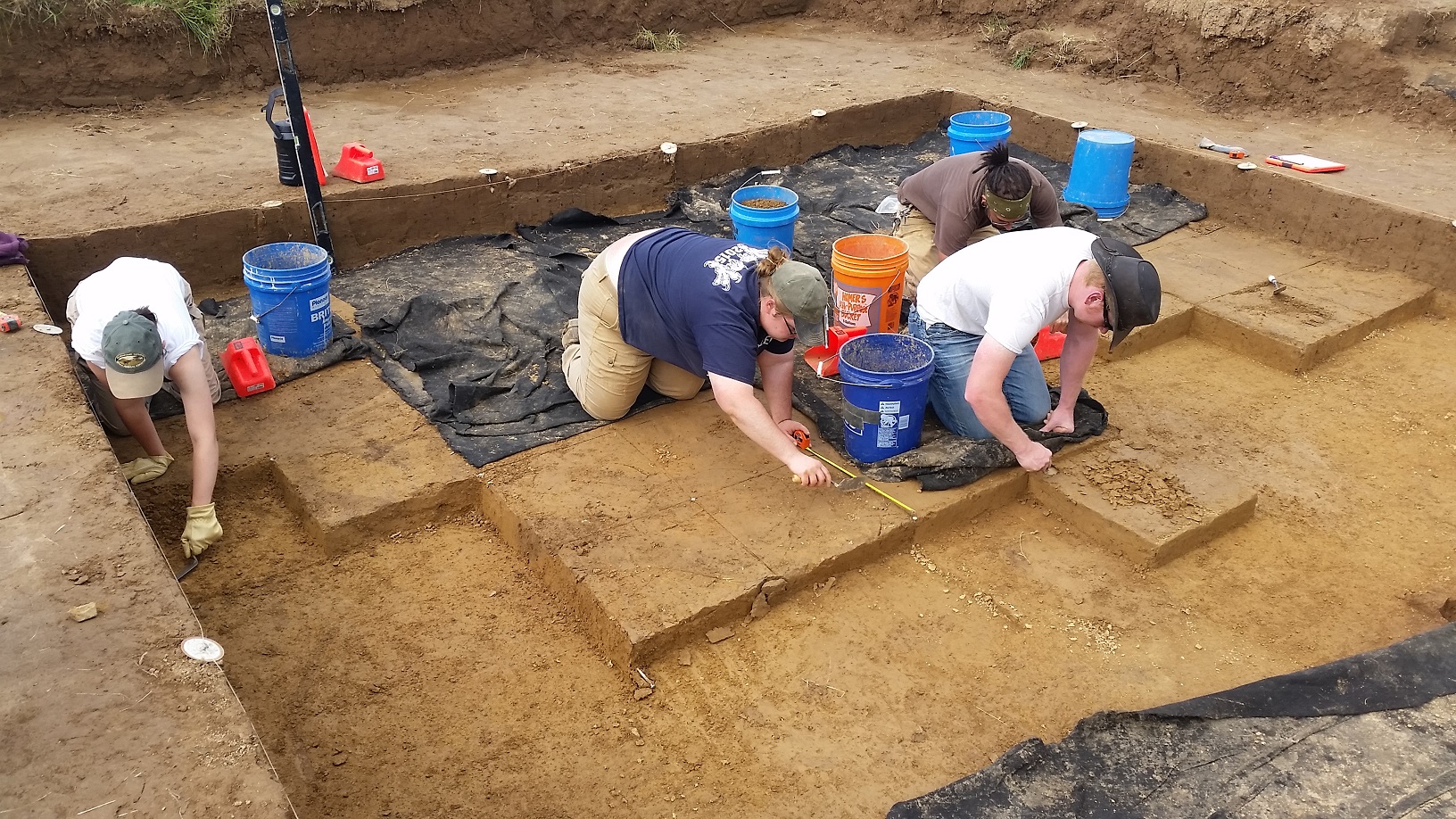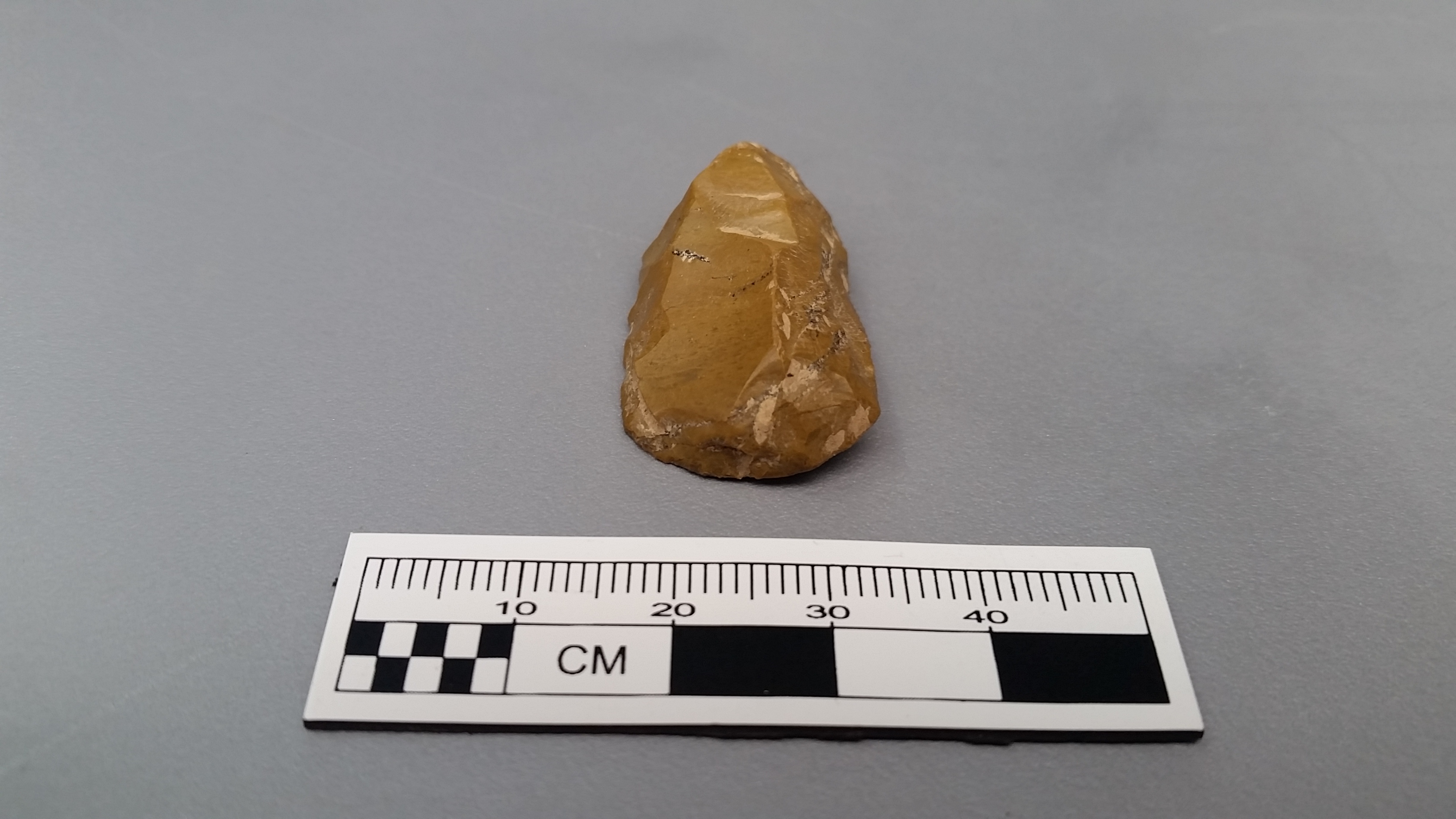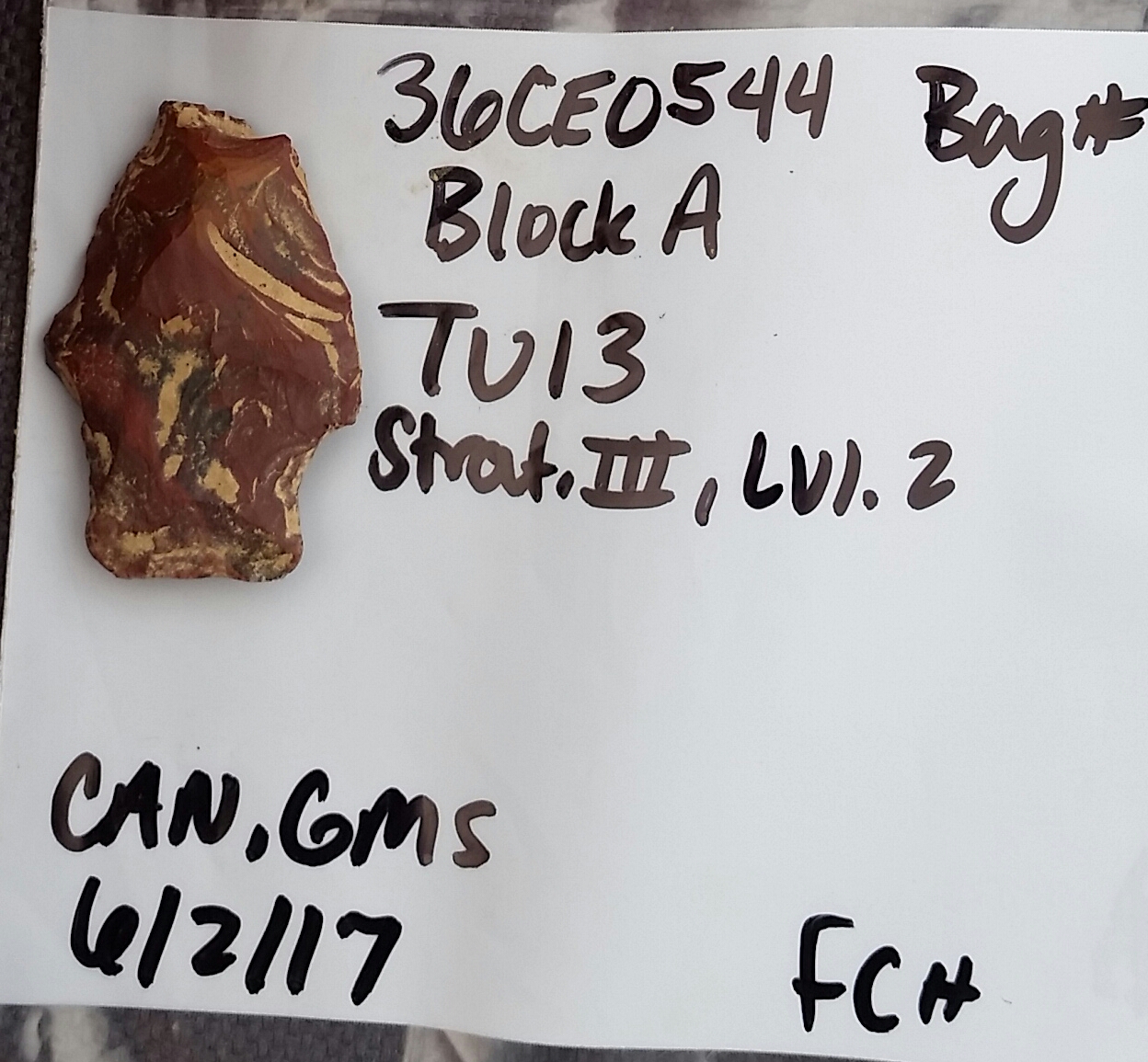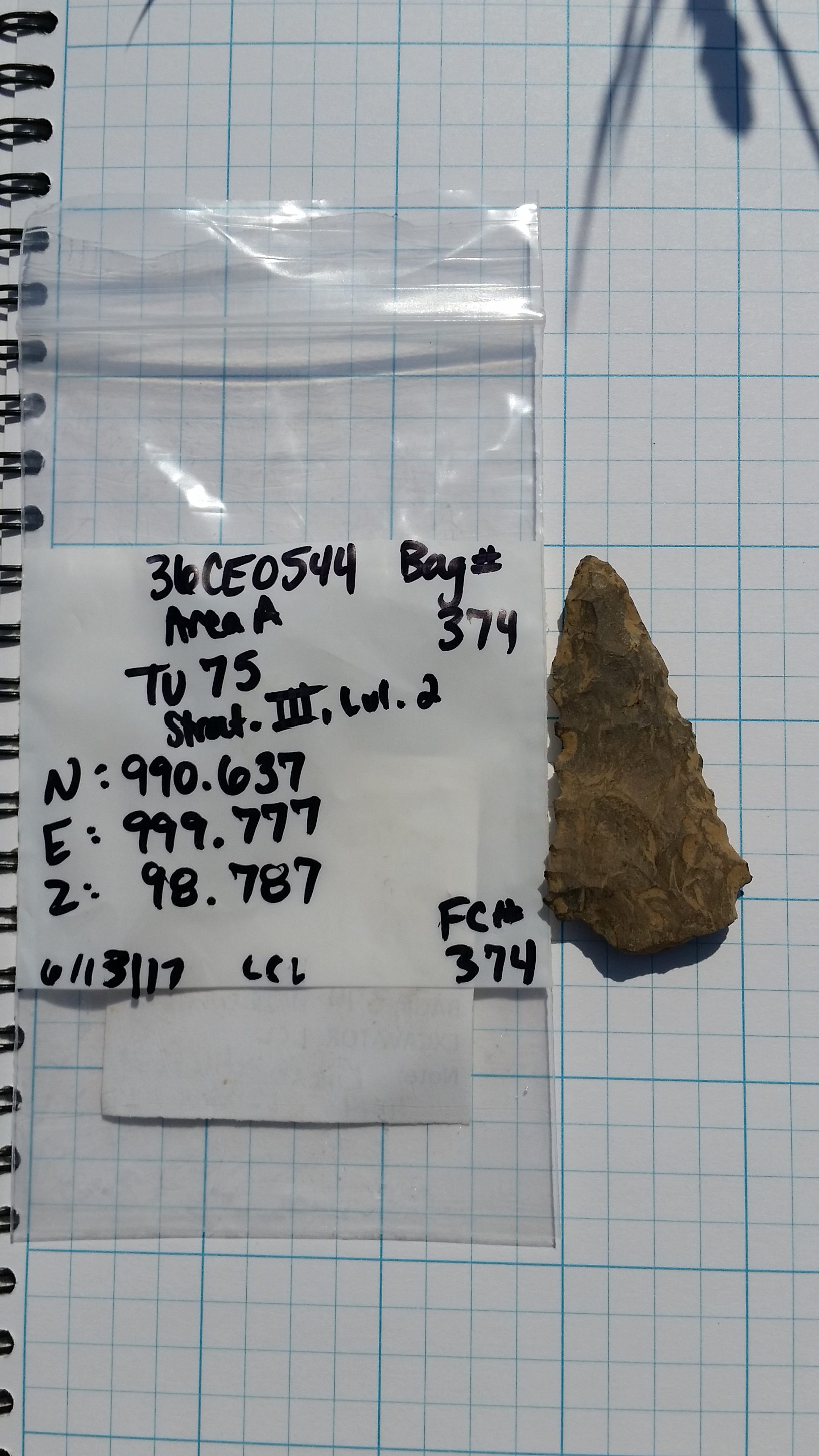This past summer I had the opportunity, along with other members of the PA SHPO, to visit an archaeological field school underway in State College. It’s not often I get away from my desk, so it was a nice chance to get out in the field and get my hands dirty helping to screen soil, even if just for a day or two. The field school was run as a coordinated effort by the Juniata College Cultural Resource Institute and the PennDOT Highway Archaeological Survey Team (PHAST) at the James W. Hatch Site (36Ce544).
Site 36Ce544, also called the Hatch site, is a precontact Native American site that was found in 2015 when PHAST was undertaking archaeological survey for a bike path and road drainage project just off the Penn State campus. It is named for James W. Hatch, a former professor at Pennsylvania State University who conducted numerous archaeological surveys in the central Pennsylvania area.

Students excavate the Hatch site in Centre County, PA.
PennDOT and Federal Highways, in coordination with the PA SHPO, determined that the site is eligible for the National Register of Historic Places and, since it could not be avoided by the project, Phase III mitigation was determined to be necessary. Because of the extremely tight budget, it was decided to do this work as a university field school assisted by the PHAST field crew. This YouTube video of the site includes a great combination of still photos and drone footage.
The site is located northeast of the Penn State campus. Oriented to the modern eye, the site is located off Orchard Road, a little less than a mile east of Beaver Stadium and just west of Slab Cabin Run. For the archaeologist in all of us, it is located about three-quarters of a mile east and down slope from the Tudek Site (36Ce238) and in the vicinity of a number of smaller pre-contact sites.
All of these sites are part of the National Register-eligible Houserville Jasper Quarry Archaeological District, which is a large area including both a quarry site and workshop sites. This area was first documented on a National Register form in 1980. As part of the mitigation project, a graduate student at Indiana University of Pennsylvania will be taking another look at the Houserville District to update the National Register information.
Stone tool production often began with digging out, or quarrying, jasper or other similar stone materials. The Tudek Site is a large jasper quarry and is the focal point of the Houserville District. Much of the Tudek Site has been impacted by past road and infrastructure projects and, as a result, the Tudek Site has been the focus of archaeological excavation and study. Evidence suggests that jasper, which was used extensively for pre-contact-era stone tools, has been mined from this site for many thousands of years.

Artifact collected from Hatch site excavations.
After removing large chunks of stone from the quarry, the material was transported to nearby areas around the quarry, or workshop sites, where larger pieces of jasper from the quarry were worked into more manageable sizes (blanks and cores), which were taken elsewhere to be made into more formal stone tools when needed. Most of the other sites in the Houserville District have been surface collected (meaning artifacts were found on the ground surface without any digging). These sites are considered to be workshop areas associated with the quarry. Most of these sites have not been as intensively investigated as the Turdek Site, which makes it an important investigation.
Results from previous PHAST investigations indicated that the Hatch Site was a workshop site. Artifacts recovered from the initial fieldwork include waste products from breaking down stone into smaller pieces – shatter, tested core fragments, core reduction flakes, and biface thinning flakes – and the majority of which were jasper. Just the sort of artifacts you would expect at a workshop site in the vicinity of a jasper quarry.

Artifact from the Hatch site excavations in June 2017.
Of particular interest was a significant number of artifacts recovered from discrete and stratified soil horizons representing buried and undisturbed past living surfaces. To an archaeologist, this is like a time capsule.
This summer’s field school began by further refining the previous excavation work. Testing began with limited shovel test and test unit excavation across the site area (to further refine the site boundaries and soil stratigraphy) which was followed by block excavation. The initial testing served not only to help further flesh out the nature of the site, but it also gave the field school students a good opportunity to experience the type of field methods they will use if they continue on in archaeology as a career. Block excavation followed and took up most of the field school.
While most of the analysis is still left to do, preliminary results confirm the presence of a stratified component at the site. Two projectile points and a scraper were recovered from the stratified soil levels. Artifacts of this sort have been recovered from some of the surrounding sites; however, they have been recovered from the ground surface. Being able to analyze these artifacts along with the other artifacts in direct association from discrete stratified soil contexts will allow the archaeologist to more fully reconstruct the activities of this site.

Hatch site projectile point.
I hope the field school students had an enjoyable and worthwhile experience this summer. I want them to know that their hard work has helped to further our understanding of Pennsylvania’s past and its important Native American history.
In closing, may your trowel be sharp, your soil loamy, and poison ivy far away.
How do I contact community archeology projects in PA and lower NY state near PA.
I am interested in volunteer digs in the region.
Thanks
Mike Kordek
Hi Mike,
The best way to get involved with community archaeology projects is to contact your local or regional chapter of the Society for Pennsylvania Archaeology or the New York State Archaeological Association. These organizations are open to anyone with an interest in archaeology (amateur or professional). Many of these groups have on-going excavations that you could participate in.
Steve
I live near this site, and remember when the students were out digging, this past week I was walking nearby and found what looks to be a carved hand held sharpen stone with symmetrical carvings on both sides of the stone who would I contact to see if this is an contributing artifact